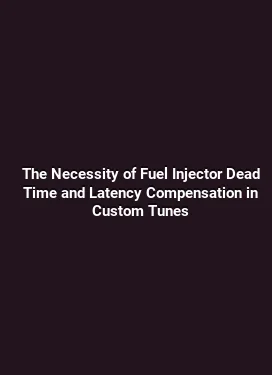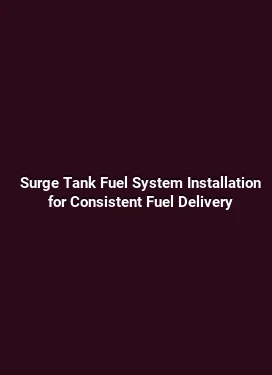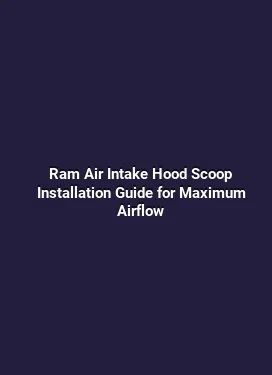How to Install Aeromotive A1000 Fuel System for High Horsepower
In high horsepower builds, fuel delivery is the backbone of performance and reliability. The Aeromotive A1000 family is engineered to meet demanding flow requirements while maintaining precision fuel pressure control under sustained load. This guide dives into practical, field-tested steps for selecting the right A1000 model, configuring the intake and fuel system, and performing a clean, dependable installation that supports aggressive fueling strategies. Expect a blend of practical tips, real-world constraints, and configuration advice that helps transform raw horsepower into reliable performance on the track or street.
Overview of Aeromotive A1000 and Install Considerations

The Aeromotive A1000 line includes high-capacity electric pumps designed to deliver consistent fuel pressure across a broad RPM range. These pumps are renowned for their robust construction, compatibility with ethanol-containing fuels, and the ability to support high horsepower targets with minimal heat soak and surge. When planning an installation, it is crucial to evaluate the target horsepower, expected fuel pressure, ethanol content, and the fuel delivery strategy (return vs returnless) to determine the appropriate A1000 model and ancillary components.
Before you begin, map out the fuel path from the tank to the engine. This involves selecting an appropriate pick-up provision, a pre-pump filter, the main pump module, a pressure regulator, and the return or returnless plumbing as dictated by the vehicle and fuel strategy. In many high-performance applications, a dedicated return line helps stabilize fuel pressure under boost, while returnless setups favor simplicity and reduced heat transfer to the fuel. A clear plan for routing, mounting, and heat management will minimize installation surprises and simplify maintenance.
Choosing the Right A1000 Model for Your HP Goals
Airflow, air-fuel ratio stability, and ramp rates are all influenced by the pump’s flow capacity. Aeromotive categorizes A1000 pumps by flow rate and pressure capabilities. A typical high horsepower street/strip build may target flows around 1000–1500+ horsepower depending on the engine’s efficiency, compression, and forced induction. The selection process should consider the following:
- Engine displacement and volumetric efficiency: Larger displacement engines with higher VE demand more fuel mass at high RPM.
- Boost pressure and timing windows: Forced induction systems require rapid fuel delivery to manage transient loads and potential knock resistance.
- Fuel type and ethanol content: Ethanol blends can reduce effective energy density and demand higher flow, especially in hot climates or during extended pulls.
- Return vs returnless architecture: Return systems maintain stable pressure at the rail but add fuel lines and heat load; returnless simplifies plumbing but may require regulator tuning to manage rail pressure under boost.
As a practical rule, align the pump model to a target range that leaves headroom for peak power and dynamic load. Over-specifying too aggressively can complicate installations and increase heat in the fuel line, while under-specifying risks lean conditions and fuel starvation under high-demand events. When in doubt, consult a performance fuel system calculator or experienced calibration partner to determine a safe operating envelope for your specific setup.
Intake and Fuel System Integration: From Tank to Rail
Integrating a high-capacity pump like the A1000 with an intake system requires careful attention to filtration, line sizing, and regulator placement. The goal is to deliver clean fuel at a consistent pressure, with minimal vapor lock and turbulence in the supply line. Start with an inline pre-pump filter to catch particulates and protect the pump from debris, particularly if the vehicle has a legacy pickup or cluttered tank area. A quality filter with a micron rating suitable for high-flow systems reduces the risk of screen clogging and flow restriction during hard acceleration.
The fuel line routing should prioritize short, straight paths with generous bending radii to prevent kinks and reduce cavitation. Use AN fittings and steel or high-grade aluminum lines that resist heat transfer from the engine bay. Position the pump as close to the tank as practical to minimize suction head and energy loss. In return systems, route the return line away from heat sources and secure it with vibration-damping mounts to maintain stable pressure during dynamic events.
Choosing the Right A1000 Model for Your HP Goals

Within the A1000 family, models vary by flow capacity and operating pressure range. For a high horsepower build, select a pump with enough headroom to supply the engine across the RPM spectrum. When the plan includes drag-based bursts or road-race sessions, a pump that can sustain elevated pressure with minimal droop under boost is essential. Consider the following practical checks during selection:
- Gauges and sensors: Integrate a reliable fuel pressure gauge at the rail or connected to the regulator to monitor real-time pressure and respond quickly to any drop under load.
- Electrical considerations: Ensure the pump circuit can handle startup current and steady-state load. A dedicated relay, resistance-protected wiring, and an appropriately rated fuse protect the system from electrical faults.
- Thermal management: In hot climates or under sustained racing, the pump and nearby lines can heat the fuel, impacting density and performance. A shielded routing path or auxiliary cooling can help preserve performance consistency.
Mounting Strategies and Engine Bay Fitment
Mounting the Aeromotive A1000 requires securing the pump in a vibration-friendly zone that avoids direct exposure to heat sources such as exhaust components. Common locations include inside a sealed hanger bracket near the fuel tank or within a protected trunk area in performance cars. If the vehicle uses a rear-mounted tank, ensure the pump stays level and the suction line remains free of air leaks. In front-mounted tank configurations, ensure the pump is protected from road debris and potential collision impacts while allowing adequate airflow for cooling.
The mounting hardware should be robust yet accessible for maintenance. Consider a modular bracket that allows quick removal if maintenance is required, especially in race setups where fuel system inspection might happen between sessions. Keep electrical harnesses organized and shielded from abrasion, using loom and protective sleeves. A well-organized installation reduces vibration-induced wear and makes diagnostics straightforward should a fuel issue arise during a test session.
Regulation, Calibration, and Fuel Pressure Management
The regulator is the heart of precise fuel delivery. In a traditional return-style configuration, the regulator maintains constant rail pressure while excess fuel is shed back to the tank. In returnless setups, the regulator is integrated into the fuel rail or located near the pump, and it modulates pressure based on feedback from the engine control unit. Both approaches require careful calibration to avoid pressure spikes, surges, or lean conditions during high load. A typical calibration workflow includes monitoring rail pressure at key RPM/load points, adjusting base pressure, and validating with a wideband air-fuel ratio sensor and a dyno pull or controlled ramp test.
Kinetic energy in the fuel line during rapid throttle transitions can cause pressure droop if the system cannot respond quickly enough. To combat this, use sufficient fuel line diameter and consider an auxiliary surge reservoir or a secondary pump in extreme setups. Regularly inspect the electrical ground and the pump relay performance, as a minor resistance rise can translate into a noticeable drop in pressure under boost. The goal is to maintain a stable fuel supply at a predictable pressure target to ensure consistent mixture and safe operation.
Maintenance, Diagnostics, and Common Pitfalls
Maintenance is more about prevention than urgent repairs. Periodically inspect filters for clogging, confirm that all connections are tight, and check for signs of fuel seepage around seals and fittings. Inspect hoses for wear, especially near heat sources or where vibrations are present. A simple diagnostic practice is to check rail pressure with the engine idling and at high RPM, ensuring the reading aligns with the regulator’s target range. If the pressure remains high or low, re-check electrical connections and verify the integrity of the return line routing.
Common pitfalls include underestimating the importance of fuel temperature management, choosing too-small fuel lines for the pump’s capacity, and neglecting proper shielded routing in the engine bay. A clean, well-organized installation not only reduces the risk of failures but also improves serviceability during tuning or upgrades. For those pushing into extreme horsepower figures, consider additional cooling for the fuel system and verified fuel mapping to protect engine longevity and reliability under track conditions.
Real-World Scenarios: Setup, Tuning, and Validation
In practice, a high horsepower street/strip setup uses a staged approach: verify the baseline fuel pressure at idle, confirm stability under light throttle, then perform controlled dyno pulls to observe pressure behavior as boost rises. Document the rail pressure, pump current draw, and fuel temperature. Use this data to refine the regulator base pressure, adjust the return flow if applicable, and tune the engine’s fuel map to maintain desired air-fuel ratios across the RPM band.
When testing, simulate real-world conditions: abrupt throttle transitions, sustained high RPM, and occasional lean dives to ensure the system can respond without dramatic pressure loss. A comprehensive testing regimen helps identify weak points such as filter restriction, wiring vulnerabilities, or routing conflicts before they become performance bottlenecks on the road or track.
As horsepower goals evolve, the fuel system architecture should adapt. Upgrading lines, adding a larger capacity regulator, or switching to a more capable pump can be part of a staged upgrade path. The key is to plan ahead, maintain rigorous documentation, and rely on tested configurations that respect the engine’s fueling needs while preserving reliability under demanding driving conditions.
Conclusion-Free Ending: Embracing a Thoughtful Fuel Strategy
Installing an Aeromotive A1000 fuel system for high horsepower is more than just dropping in a pump. It is about designing a coherent fueling narrative that aligns with the engine’s needs, the vehicle’s architecture, and the intended driving scenarios. The approach emphasizes careful component selection, meticulous routing, robust electrical integration, and a disciplined calibration routine. With this framework, the high horsepower goal becomes not just achievable but repeatable and reliable across sessions and conditions.






